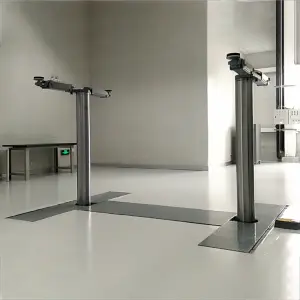
Understanding the Benefits and Applications of Inground Lifts in Automotive Service Facilities
****
In today’s fast-paced automotive industry, efficiency and safety are paramount for any service facility aiming to stand out. One of the most significant advancements in automotive repair technology has been the introduction of inground lifts. These lifts provide a seamless, reliable, and effective solution for vehicle maintenance, allowing mechanics to work at optimal levels while ensuring safety and comfort. To appreciate why inground lifts have gained popularity, it is essential to understand their benefits, applications, and some considerations for installation.
What Are Inground Lifts?

Understanding the Benefits and Applications of Inground Lifts in Automotive Service Facilities
Inground lifts are hydraulic or pneumatic lifting systems installed below the concrete floor of a garage or service station. Unlike traditional above-ground lifts that occupy valuable space and require significant headroom, inground lifts are hidden when not in use, allowing for a clear and unobstructed work area. When activated, these lifts raise vehicles by securely holding them at a comfortable working height, making them ideal for various types of repairs and inspections.
Advantages of Inground Lifts
1. **Space Efficiency**: One of the most notable benefits of inground lifts is their ability to maximize space. Since they are installed below ground, they do not interfere with overhead space, leaving room for lighting, tools, and other equipment to be utilized effectively. This makes inground lifts particularly advantageous for smaller service shops where every inch counts.
2. **Safety Features**: Safety is crucial in any automotive workshop, and inground lifts are designed with various safety features to protect both the vehicle and the worker. They often come equipped with safety locks that engage automatically when raised, preventing unintended drops. Additionally, many inground lifts are designed to minimize the risk of accidents associated with slipping or falling, further enhancing workplace safety.
3. **Durability and Maintenance**: Engineered to withstand heavy usage, inground lifts are typically constructed with robust materials intended for longevity. Their underground installations reduce exposure to elements such as moisture, chemicals, and temperature variations, giving them an advantage over traditional lifts in terms of durability. Routine maintenance is generally easier and less time-consuming, ensuring that the lifts remain operational with minimal downtime.
4. **Versatile Work Environment**: Inground lifts can accommodate various vehicle sizes, from passenger cars to larger trucks. Some models even allow for enhanced capabilities, such as the ability to lift vehicles high enough for tire changes and brake overhauls. This versatility makes them a valuable asset for repair shops of all sizes and specialties.

Understanding the Benefits and Applications of Inground Lifts in Automotive Service Facilities
5. **Improved Accessibility**: With a flat floor when not in use, inground lifts offer improved accessibility for both mechanics and customers. This design allows for easy movement of tools, equipment, and people within the work environment, enhancing efficiency and workflow.
Applications in Automotive Services
Inground lifts are suitable for a broad range of applications in automotive service facilities. They can be utilized for servicing vehicles during routine maintenance, including oil changes, tire rotations, and brake checks. They are also used for more extensive repairs, such as engine replacements, transmission work, and body repairs. Additionally, inground lifts are instrumental in inspections required for vehicle compliance with safety and emission standards.
Considerations for Installation
While the benefits of inground lifts are numerous, several factors should be considered before installation. First, a significant initial investment is required, which may be a barrier for smaller shops operating on tight budgets. Moreover, proper planning is essential during installation, as the excavation must be precise to ensure that the lift fits and functions correctly without any potential damage to the surrounding infrastructure.
Furthermore, it is vital to have solid plumbing and electrical systems in place to support hydraulic or pneumatic operations. Professional installation is highly recommended to ensure compliance with safety regulations and optimal performance.
Conclusion
Inground lifts represent a significant advancement in automotive service technology, offering numerous advantages over traditional lifting systems. They provide a safe, efficient, and versatile work environment that enhances productivity in automotive service facilities. While there are considerations to take into account prior to installation, the long-term benefits of efficiency, safety, and durability make inground lifts a worthwhile investment for any serious mechanic or service shop. By embracing this innovative technology, automotive businesses can better position themselves for success in an increasingly competitive market.quick car jack lift
